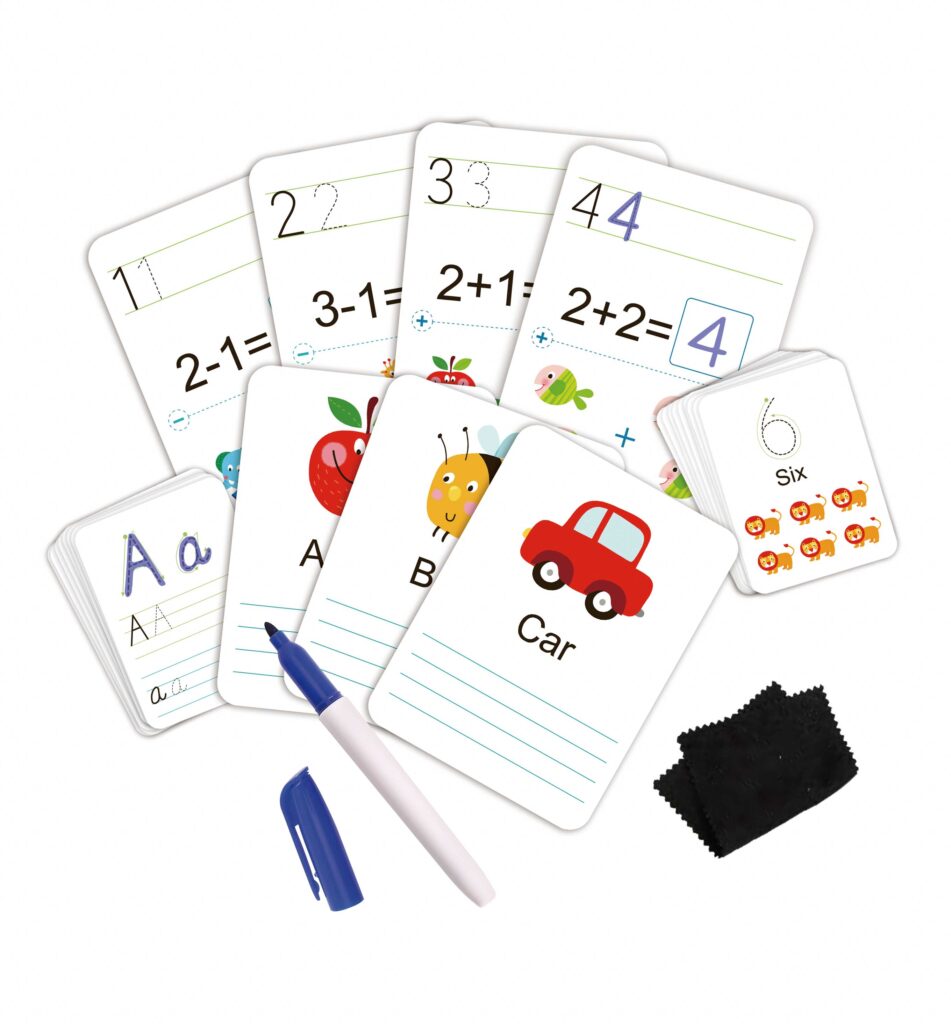Educators typically begin teaching counting concepts to kids in kindergarten and first grade, but actually, we can begin teaching our child math skills earlier. The skills we teach our child can serve as a foundation the child can draw upon when teachers introduce math concepts in kindergarten.

Benefits of Teaching Counting
Teaching preschoolers to count will improve their readiness for other math concepts that will be taught in the future, such as addition and subtraction. One way to start is to tell your child how old he is while holding up the correct number of fingers. Then ask him to do the same.
If your child is not ready to model this behavior, simply continue to occasionally show him. Eventually, he will hold up the correct number of fingers. When he does, say, “That’s right!”
Teaching children to count can be fun and easy by using simple strategies that will help your child develop a fondness for numbers. Below are some for reference.
Strategy #1. Using everyday objects to teach toddlers counting
Counting is one of the easiest and most effective ways to introduce toddlers to numbers. You can count everyday objects like the number of spoons on the table or the number of stairs in your house.
When a child is in the toddler stage, we can begin teaching numbers by emphasizing, verbally, that some things are big, and some are small. We can also hold up a stick and say, “it is very tall, it is bigger than this stick!”
Kids can see that obviously, there are differences between quantities and size. But putting a name to those quantities and sizes is what comes next. That takes learning concrete symbolism for numbers and counting.
Strategy #2. Teach toddlers to count by making numbers funny learning
In a way, we are talking about memorization techniques here. And, while flashcards with numbers on them, and dominoes with dots on them, can be helpful, we are not talking about sitting a toddler at a desk and asking them to learn by listening carefully. Children learn through play. Even better, when they can manipulate and touch objects while learning, their memory of those concepts can be strengthened. This is called kinaesthetic learning, or tactile learning.
So, how do we make counting fun for toddlers?
Number games!
Sing songs about numbers! Just like we learn the alphabet song to memorize the alphabet in a fun way, we can also sing songs about counting. “One, two, buckle my shoe” and “5 little monkeys jumping on the bed” are definitely relevant here. YouTube will have plenty more songs and ways to teach numbers to children.
During story time, before bed, we can also play a simple game of ‘repeat after me.’ Ask our child to repeat the word, “one,” then “two,” then “three” and so on. Keep doing this until they learn that there is a pattern to be followed.
Next
Try to switch turns saying the numbers. You say, “one,” and then pause and say, “what’s next?” At first, they may not know, because they may not have understood that this fun game is about remembering. But eventually, they’ll get the queue to say “two” after one, and “three” after two, and so on. They may also go out of sequence, but you can correct them by saying the right number, if they skip one or two.
At this point, they are learning random words through memorization. The idea that these words have to do with quantity may not sink it yet.

Use toys to help teach numbers
Tooky Toy have many number-related wooden toys for choice, below are some examples:
Counting Stacker
This stacker toy is suitable for kids 12m+, it helps babies develop their fine motor skills by requiring them to stack the pieces on top of one another. Moreover, it also helps them learn to count and sort objects. The small pieces are easy to hold with little hands, and with the color-coded and numbered, so children can match them and count them as they stack.
Number Sound Puzzle
This puzzle is suitable for baby 18m+, could be a move-forward toy of the above stacker toy. It can help to develop baby’s fine motor skills and hand-eye coordination. When toddlers pick up one piece of puzzle, it will make different sounds, thus it can be an excellent tool for language development, as toddlers can learn numbers by hearing the sounds. Moreover, as toddlers love interactive toys, this sound puzzle can keep them engaged and entertained for extended periods, allowing parents or caregivers some free time.

Hand Writing & Learning Cards
This card set is suitable for 3y+ kids. Writing numbers by hand and creating learning cards helps to improve memory retention. Meanwhile, handwriting and learning cards involve active learning, which is a more engaging and effective way to learn. What’s more, it is portable, which means that you can take them with you wherever you go. This makes it easy to study and review the material whenever you have a spare moment, such as during a commute or while waiting in line.

Start with small increments of number memorization with toddlers
And important note here: don’t expect your child to reach 10 by starting with 10 numbers to memorize. That’s too hard for a two or three yearsold. Instead, start with “one, two, three!” You can keep saying this as though it’s a common phrase. They may even repeat with “one, two…” and that’s ok! You can make “three” the big ‘celebratory’ number. Clap and say, “threeeeee!”
Then, you can move on to “four, five,” and so on.
Strategy #3.Teach 2D representations of numbers to toddlers and preschoolers, and mix up sequences and patterns to teach individual numbers to preschoolers
What do we mean by 2D representations of numbers? This is basically writing out numbers on paper, or using flash cards. Let preschoolers see the written number 1, and understand that when you say, “one,” and they say, “one” that it is referring to that graphical character. Then likewise with 2, 3, 4 and so on.
You can also draw dots next to the numbers, or use dominoes or dice, to show children that numbers also relate to quantity.
You’ll notice children’s counting books use this same method. Except, instead of dots, they’ll show pictures of say, two apples, three flowers, four friends, and so on. This also helps children with language development, vocabulary, and the association between quantity and numbers.
Read these types of early learning books to children every day. In a gamified and storyful way, you can ingrain the thought that printed numerals, verbal words and quantities of objects are all related to each other.
The human mind is amazing. You won’t need to do much explaining of how this works. Children will pick up patterns, and learn to repeat, until they ‘get it’ by ‘doing.’ Just remember to make it fun, so they’ll want to!
When a child has a grasp on numbers, and is fairly confident about saying them in order (typically up to 10), you can start with a few ‘tricks.’ There are plenty of workbooks and worksheets to help with this. They will display a set of numbers in random order. Ask your preschooler, “where is number seven?” You can help them search the page, or point to the wrong one and say, “is that number seven?” If they say, “yes,” you say, “nooooo” like it’s a silly game. Then ask again by pointing to another, “is that number seven?” and repeat until they get it right. When they get it right, you give them a, “yaaaay! Good job!” and a high five.
Come back to this activity as they learn to counter higher and higher.
Strategy #4.Constantly count physical objects with children to teach numbers
Finally, when you’re with your toddler, like with all lessons, try to apply them in real life. When playing with blocks, stack them and count, while pointing, “one, two! That’s two blocks!” When you cut up little banana pieces for a toddler, show them their plate and count the pieces (obviously don’t count higher than they’re able to understand). You can say, “there are three pieces left! One, two, three” and point while you count them.
You can do this by lining up pebbles in the park, or by counting shoes when putting them on, and so on. Make counting part of their thought process, so they begin to recognize quantity. They should be able to understand beyond just ‘more’ and ‘less’ or ‘big’ and ‘small,’ and so on.
To Conclude Teach toddlers and preschoolers to count by actively bringing numbers into their lives
Children can learn to count at around age 2. Of course, some cases will always be different (either earlier or later). But to gauge a good age at which to start introducing numbers, you can start when they are toddlers. Don’t expect to make big strides at first, of course. They’re still taking in a lot at that age. Letters, numbers, objects, words, sounds, sensations – they’re absorbing it all, and rapidly, too.
We should make numbers part of the ‘norm’ in their lives, such as by playing, singing or pointing out quantities, you can teach counting in early childhood fairly easily. That way, by the time they enter preschool or kindergarten, children can have a base to build upon more advanced math skills.
The End of Tooky
Tooky is a leading 18 years wooden toy supplier based in China. Below are our main 7 values. If you are interested in importing wooden toys, feel free to CONTACT us.
1) Products-Over 500 fine-selected products + over 40 quarterly new launches.
2) Free customized designs-9 experienced product managers, will convert toys into with your brand characteristics
3) Customized package-4 packaging experts offer not only safe packages, but legal labeling for market access
4) Test report-Not sure of testing standards? You can leave the test with us till we get a final “pass” report as the market requires
5) Lifestyle pictures-Never feel helpless about marketing! Will offer you lifestyle pictures if you need
6) Short videos-Check with our sales for “Short Video Paid-Service & Discount Program”
7) Exclusivity program-After spending a tremendous amount of resources on marketing and advertising, we may see competitors sharing our fruits of labor by carrying very similar products. How to obtain some kind of protection? An “exclusivity program” needed to be put in place, check with our sales.
Any comments, pls contact me candy@trade-internet.com











5 回复
Everything is very open with a really clear description of the issues. It was definitely informative. Your site is useful. Thank you for sharing!
Thanks for sharing. I read many of your blog posts, cool, your blog is very good.
Thank you for your sharing. I am worried that I lack creative ideas. It is your article that makes me full of hope. Thank you. But, I have a question, can you help me?
Thanks for sharing. I read many of your blog posts, cool, your blog is very good.
Can you be more specific about the content of your article? After reading it, I still have some doubts. Hope you can help me.